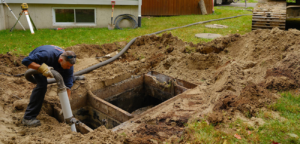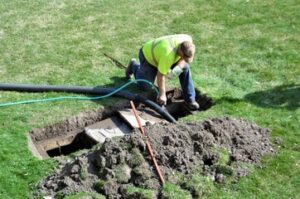Concrete Contractors provide expertise and skill to a variety of concrete projects. They are responsible for project planning, site preparation, concrete pouring, finishing, and quality control.
They often start as laborers on a concrete crew and may participate in an apprenticeship program that provides on-the-job training and instruction. To keep schedules on track, they must have strong responsibility and time management skills. Contact Concrete Contractors Conroe TX now!

Concrete contractors lay, pour, and finish concrete. They work on various commercial and residential construction projects, including patios, sidewalks, driveways, and walls. They also construct foundations and shafts for fabricated steel tanks, vessels, and structures.
Working as a concrete contractor requires special skills, such as reading blueprints and measurements, operating power tools and preparing the site for concreting. These contractors may also need to pour, finish and repair existing concrete. They must understand how to operate concrete trucks and mixers and have excellent attention to detail.
They begin by collaborating with the general contractor and architects to plan concrete projects. They determine the amount of concrete needed and how it will be delivered to the project site. Then, they prepare the construction area by clearing debris and leveling the ground. They also set up forms and reinforcements to ensure that the concrete is poured evenly and according to specifications.
When it comes time to pour, these experts use the formwork and reinforcements they created as guides. They carefully mix and transport the concrete to the construction site, where they pour it into place. They then smooth and finish the concrete, using tools such as trowels and floats. Finally, they seal and protect the concrete from environmental damage, and they continue to monitor and inspect it as it cures.
In addition to their concrete-related duties, these professionals must keep up with industry best practices and safety standards to maintain a safe workplace for themselves and the other members of their crews. They also regularly check on the progress of their projects to make sure they are adhering to schedules and delivering high-quality workmanship.
Since concrete is the most used building material in modern construction, there is a high demand for concrete subcontractors. As a result, these professionals can expect competitive compensation and healthy job prospects in the near future. With that said, the key to success for these experts is maintaining a solid foundation of good employees. They must treat their workers well and pay them enough to be invested in the company, which means they will perform better on the jobsite and be more likely to recommend their services to others.
Education and Training Requirements
Concrete contractors must meet educational and training requirements to be licensed to work in the field. Some states have additional requirements, such as a criminal background check and a posted bond. Some also require continuing education to keep licenses current. Masonry programs offer classroom and hands-on training to learn the basics of the trade, from blueprint reading and architectural drawing to job site safety.
Depending on the project, concrete contractors must be strong enough to use heavy equipment and handle large loads of materials. They may have to stand on their feet for several hours and lift heavy objects. They must wear protective clothing to avoid being exposed to toxic chemicals and dust. The physical demands of this job also include long hours and outdoor working conditions.
The cost of raw materials can have a significant impact on the profitability of this industry. Moreover, rising construction costs have squeezed margins for many concrete contractors. This has led to consolidation within the industry, with fewer players competing for the same customer base.
It’s important for concrete contractors to focus on the market they want to target. For example, a business can choose to concentrate on residential projects that involve pouring patios and walkways in people’s backyards, or it can opt to pursue commercial projects such as schools and offices, government buildings and public works. This will help determine the type of tools and skills the company needs to develop its employees and achieve success in its chosen market.
Whether an individual works for a general construction contractor or as a specialist, they must take part in the NRMCA Pervious Concrete Contractor Certification program to gain industry-specific knowledge of concrete pavement design and installation. The program is a mix of classroom and on-the-job training that includes a two-hour written examination. Those seeking re-certification must pass the exam with a score of 75% or higher and submit documentation of work experience. In addition, NRMCA provides training for ready mixed concrete plant personnel, inspectors, engineers and admixture manufacturers who must have an understanding of pervious pavement.
Working Conditions
Professional concrete contractors are well-versed in local building codes and regulations. They ensure that all of the steps for a project are taken care of, including securing necessary permits and inspections. This ensures that the final product is safe and up to code. They are also familiar with the different types of concrete and how to best use them for a given situation.
They know how to mix, pour, shape, and finish concrete in a way that produces high-quality results. This means that you don’t have to worry about making mistakes that can be costly in the long run. They also have access to specialized tools for concrete construction that are not readily available to DIY enthusiasts or homeowners, allowing them to work more quickly and efficiently without compromising quality.
Working conditions for a concrete contractor can be quite demanding, especially when working outdoors. It is important for them to wear the proper personal protective equipment (PPE) at all times to protect themselves from the harsh effects of working with concrete. This includes safety glasses with full-coverage lenses, face masks, and hard hats. It is also essential for concrete contractors to have regular safety meetings and reminders to avoid accidents or injuries in the workplace.
Concrete is a very heavy material, so it is also important for concrete workers to stay physically fit and healthy. The work can involve prolonged periods of standing, bending, or kneeling, and may require lifting and carrying heavy materials. It is also common for concrete work to be performed in weather conditions that can be hot, cold, or wet.
Lastly, concrete contractors need to be good communicators. They must be able to convey technical details in a way that others can understand, and they must communicate changes in plans or scheduling effectively. This is particularly important for larger projects, where the concrete contractor must be able to coordinate with multiple team members.
One of the biggest challenges of a concrete contractor job is keeping consistent quality. This is because a variety of factors can impact the final quality of the finished product, including the concrete mix, curing conditions, and workmanship. To reduce the risk of defects that require costly repairs, a concrete contractor should implement strict quality control measures, including training employees on proper safety protocols and regularly inspecting equipment to prevent accidents and injuries.
Job Outlook
The global concrete contractor market is growing in accordance with the advancing degree of urbanization, industrialization, and infrastructural developments. The gradual shift of building contractors and consumers toward cost-efficient, eco-friendly, and modern construction techniques is also driving the market growth. Furthermore, rising disposable income of people is expected to aid the housing construction and boost the demand for concrete contractors over the forecast period.
A successful career as a concrete contractor requires extensive training and hands-on experience. You need to understand how to work with different types of equipment and materials, as well as how to construct and maintain the structure you’re working on. You can obtain these skills through a vocational school, apprenticeship, or on-the-job training.
In addition to your education and hands-on experience, you need a strong business sense to succeed as a concrete contractor. You must know how to budget construction labor costs and acquire the appropriate tools and equipment. You should also consider investing in a workforce management solution, such as Bridgit Bench, to streamline operations and gain valuable insight into your construction team’s performance.
A concrete contractor must also have the right insurance policies to protect himself from liability claims. For example, if someone trips over your wet concrete or your equipment causes damage to the property, you need general liability insurance to pay for damages and defense costs. In addition, you should get commercial general liability insurance to cover damages and legal fees if customers or vendors sue your company for negligence or defective products.
Larger concrete contractor companies often employ project managers to oversee the financial aspects of their projects. These professionals are responsible for acquiring and distributing materials, assessing job sites, assigning field laborers, auditing jobs, and more. In some cases, they’re also responsible for ensuring that their construction teams are on schedule and within budget.
Some concrete contractors work for private individuals or businesses while others work for government agencies. Regardless of the type of job, a concrete contractor must be willing to travel and work long hours. Moreover, they must be comfortable in outdoor environments and working in compact spaces.


